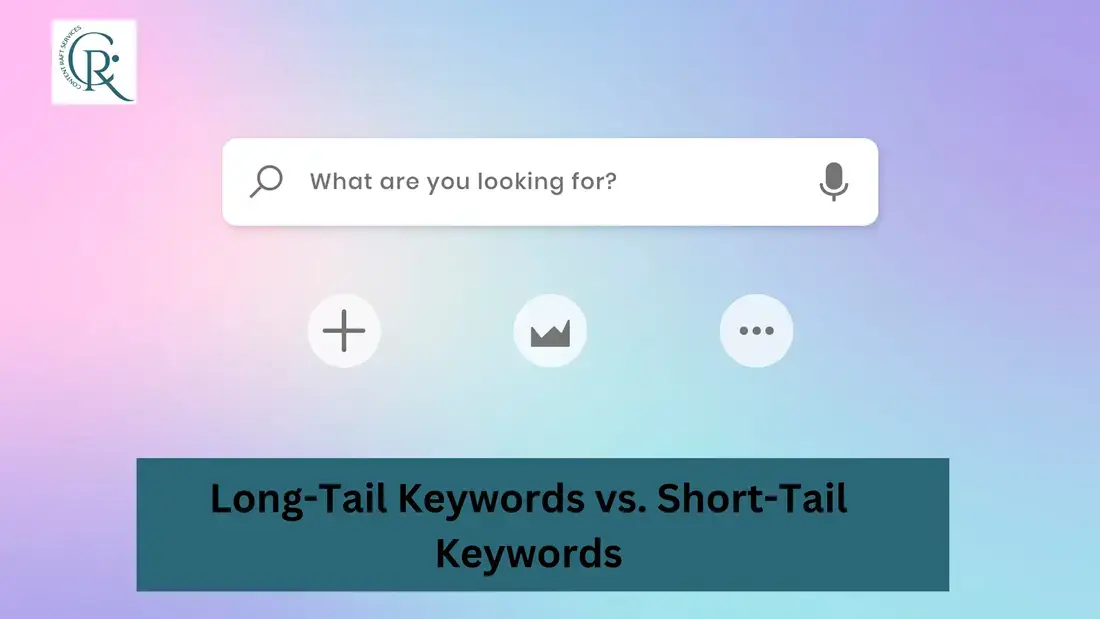
When optimizing content for search engines, understanding the difference between long tail keywords vs short tail keywords is crucial. While both have their advantages, prioritizing long-tail keywords can often yield better conversion rates and more precise targeting of user intent. This guide explores the key differences, strengths, and ideal use cases for each.
Long Tail Keywords vs Short Tail Keywords
What Are Short-Tail Keywords?
Definition
Short-tail keywords (also known as “head terms”) are broad search queries made up of one or two words.
Examples
-
“Shoes”
-
“Pizza”
-
“Travel”
-
“HVAC repair”
Key Characteristics
| Feature | Description |
|---|---|
| Length | 1–2 words |
| Search Volume | Very high (10,000+ monthly searches) |
| Competition | Very high (hard to rank without authority) |
| User Intent | Broad; often informational or general |
| Conversion Rate | Low (unclear what the user wants exactly) |
Use Case Example
A new HVAC business trying to rank for “air conditioning” will face enormous competition from manufacturers, big service companies, and Wikipedia-level pages. Even with a solid SEO effort, it may take years to rank well—if ever.
What Are Long-Tail Keywords?
Definition
Long-tail keywords are specific phrases—usually 3+ words—that target a niche or clearly defined search intent.
Examples
-
“Best running shoes for flat feet”
-
“Affordable HVAC repair in Pasadena”
-
“Vegan pizza delivery near me”
-
“Air conditioning installation for schools in California”
Key Characteristics
| Feature | Description |
|---|---|
| Length | 3+ words |
| Search Volume | Low to medium (10–500 monthly searches) |
| Competition | Low to moderate |
| User Intent | Specific and actionable |
| Conversion Rate | High |
Use Case Example
An HVAC company targeting “24/7 HVAC repair services in dubai” is much more likely to rank and get leads quickly—even if search volume is modest. The intent is strong, and the audience is actively looking to hire someone.
Real Keyword Data Comparison
| Keyword | Type | Monthly Searches (U.S.) | Competition | CPC (Cost Per Click) |
|---|---|---|---|---|
| “Shoes” | Short-tail | 300,000+ | Very High | $1.20 |
| “Best shoes for nurses on feet all day” | Long-tail | 1,800 | Medium | $2.50 |
| “HVAC repair” | Short-tail | 27,000 | High | $18.00 |
| “Emergency HVAC repair in dubai” | Long-tail | 150 | Low | $24.00 |
Source: Google Keyword Planner + Ahrefs
Why Long-Tail Keywords Are Often Better for ROI
-
Higher Intent: Users searching for “affordable AC repair in Inglewood” are likely ready to call someone.
-
Lower Cost in Ads: In PPC campaigns, long-tail keywords often cost less and convert better.
-
SEO Wins Faster: Easier to rank in Google, especially for newer websites or local businesses.
-
Voice Search Friendly: With voice assistants, people ask more conversational and long-form questions.
When Should You Use Short-Tail Keywords?
Short-tail keywords are useful if:
-
You’re building brand awareness.
-
You have a high domain authority site.
-
You want to rank for broad topics with evergreen content.
Example:
A national travel website might go after “travel destinations” to attract top-of-funnel traffic, then direct readers to more specific guides.
When Should You Use Long-Tail Keywords?
Long-tail keywords are best for:
-
Lead generation and sales pages
-
Local SEO and service-based businesses
-
Blog content that answers specific questions
-
New or niche websites with low authority
Example:
A new blog could write an article titled “Best time to visit Dubai in winter” instead of trying to compete for “visit Dubai.”
How to Find the Right Keywords
1. Google Autocomplete
Type a keyword into Google and look at the suggested searches. These are real queries users are typing.
Search “best shoes” → Suggestions:
-
Best shoes for walking all day
-
Best shoes for plantar fasciitis
-
Best shoes for wide feet
2. People Also Ask
Use Google’s “People also ask” box to generate long-tail ideas you can turn into FAQ or blog content.
3. SEO Tools
Use tools like:
-
Ahrefs: Find keyword difficulty, search volume, and competitor ranking data.
-
SEMrush: Analyze what keywords competitors rank for.
-
Ubersuggest: Free starter tool for keyword ideas.
4. Internal Sources
-
Talk to your sales team or customer service reps about common questions.
-
Review chat logs or email queries for repeated terms or needs.
Content Optimization Strategy
For Long-Tail Keywords:
-
Titles: Use the full phrase naturally in the page title.
-
H1/H2 Tags: Place long-tail keywords in subheadings.
-
Body Text: Integrate variations without stuffing.
-
Meta Description: Summarize with the keyword and user benefit.
-
Alt Text: Add keyword-rich alt text to images.
-
Internal Links: Link related articles or services using anchor text that includes the keyword.
For Short-Tail Keywords:
-
Use them in category pages, pillar content, and broad overviews.
-
Build internal links to long-tail keyword content that ranks more easily.
Which Keyword Type Should You Use?
| Business Stage | Best Keyword Strategy |
|---|---|
| New Websites | Focus on long-tail for quick wins |
| Established Brands | Mix of short-tail for reach, long-tail for conversions |
| Local Businesses | Prioritize long-tail with geo modifiers |
| E-commerce Sites | Use long-tail for product pages, short-tail for category pages |
Not sure how to put your keyword strategy into action? Partner with a reliable SEO agency in UAE to strengthen your online presence. From uncovering effective short-tail and long-tail keywords to improving your website’s search performance, a skilled SEO team can help drive the right traffic, increase conversions, and keep your business competitive.
Whether you’re a new business or a well-established company, our SEO experts in the UAE create data-driven strategies designed to meet your unique goals. Let us help you expand your reach and connect with the audience that matters most.
Get in touch today for a free SEO audit and see how we can support your growth online!
Conclusion
Both long-tail and short-tail keywords have a place in an effective SEO strategy. Long-tail keywords are best for targeting specific audiences and driving conversions, while short-tail keywords help attract broad traffic and build brand awareness. A balanced approach, leveraging both types strategically, can enhance your website’s visibility and overall search engine performance.
FAQs on Keywords and SEO
1. When should short-tail and long-tail keywords be targeted?
- Short-tail keywords should be targeted for broad visibility and high search volume but are more competitive. Use them for brand awareness and high-traffic pages.
- Long-tail keywords should be targeted when you want more specific, intent-driven traffic, typically with lower competition and higher conversion rates.
2. Why should you target long-tail keywords?
- Lower competition compared to short-tail keywords.
- Higher conversion rates as they match user intent better.
- Easier to rank for, especially for new websites.
- Help capture voice search queries and conversational searches.
3. Where should you try to place long-tail keywords?
- Title tags and meta descriptions.
- Headers (H1, H2, H3) in blog posts or web pages.
- Naturally within the content body.
- Image alt text and captions.
- URL slug and internal links.
4. What is an example of short-tail and long-tail keywords?
- Short-tail keyword: “HVAC repair” (broad, high search volume).
- Long-tail keyword: “affordable HVAC repair services in Dubai” (specific, lower competition).
5. What are the disadvantages of long-tail keywords?
- Lower search volume, meaning less overall traffic.
- Require more content creation and optimization efforts.
- Can be difficult to predict search intent accurately.
6. What is an LSI keyword in SEO?
- LSI (Latent Semantic Indexing) keywords are conceptually related terms that search engines use to understand content context.
- Example: For “digital marketing,” LSI keywords could be “SEO,” “social media marketing,” and “PPC advertising.”
7. Does Google use LSI?
- No, Google does not explicitly use LSI. Instead, it uses advanced machine learning and Natural Language Processing (NLP) to understand content relevance and search intent.
8. What is NLP in SEO?
- Natural Language Processing (NLP) is Google’s AI-based technique to understand human language, context, and intent behind search queries.
- Google’s BERT and RankBrain use NLP to improve search result accuracy.
9. What is the difference between LSI and long-tail keywords?
- LSI keywords are semantically related words that provide context (e.g., synonyms, related concepts).
- Long-tail keywords are longer, more specific phrases used to target niche audiences and match user intent more precisely.
